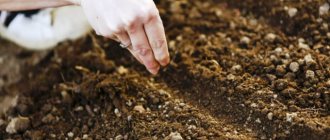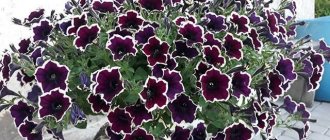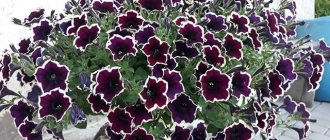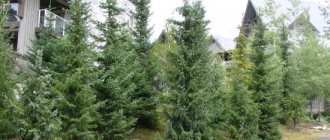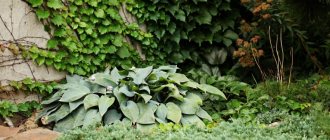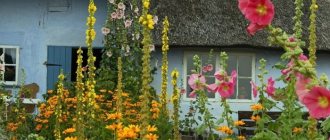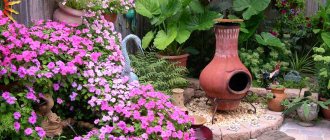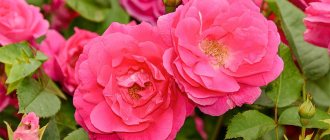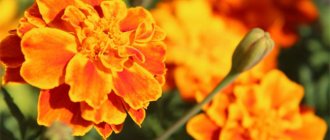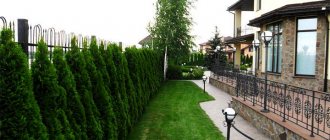Lavender
English and French varieties of lavender are well suited for outdoor growing.
Some of them grow up to 80 cm in height and look rich in large floor tubs, but there are also dwarf varieties that can be displayed on the loggia in a neat group. Small purple flowers exude a delicate, calming aroma for which this culture is so valued. Lavender blooms from May to August and does not require careful care - it is enough to provide it with loose alkaline soil mixed with river sand.
Some growing tips
|
Whatever plants you choose for your container garden - drought-resistant or moisture-loving, the most pressing issue in care will be the provision of moisture. If it is not possible to monitor the condition of the soil daily, make sure in advance that the plants do not need anything. Keep in mind that in wooden and unglazed clay containers the soil dries out faster than in plastic ones. But you can make old clay pots grow moss and partially get rid of this drawback. There are beautiful terracotta-like containers made of rubber-like porous material that are difficult to distinguish from clay ones by appearance, with the advantage that they are very light and easy to carry. Nowadays there is a wide selection of plastic flowerpots on sale, equipped with a drip irrigation system - the water in them is consumed gradually, and the soil moisture is easily controlled.
If you cannot afford expensive flowerpots with drip irrigation, it is especially important to properly prepare the substrate. As a base, you can use high-quality commercial soil for flowering plants or a universal one. They have a common drawback - they are made on a peat basis and dry out quickly. To adapt it for container plants, you must add loam (good garden soil) or compost containing clay inclusions. The soil should remain homogeneous, light and breathable. There are also special additives for retaining moisture - clay granules "Ceramis" and Hydrogel. It is better to pre-soak the ceramic, and add the Hydrogel dry and soak it together with the soil.
In order for plants to develop well and bloom luxuriantly, they need good regular nutrition. If purchased soil is used for planting, it already contains a certain amount of fertilizers, however, they are quickly exhausted by the plants in the limited volume of the container. Therefore, fractional fertilizing is done every 2 weeks (in late spring and early summer - with complex fertilizers with a predominance of nitrogen, and from July - with a predominance of potassium and phosphorus). It is even more convenient to use high-quality long-acting complex mineral fertilizers, which are mixed into the soil or incorporated into the soil around the plant 2 weeks after planting. The leader among them is the Osmocote brand - this is a capsule fertilizer that gradually releases elements through osmotic processes. Also, granular fertilizers of the Pokon, Greenwold, Seramis brands have a prolonged effect, and an economical option is Fertica. Japanese organic fertilizers “Aburakasu” have an excellent effect; their green “carnations” just need to be stuck into the ground 2 weeks after planting, and you can forget about fertilizing for the whole season.
Petunia
This annual is popular because of its incredible variety of colors. Petunia is universal; it can be kept either indoors or in a flower bed. Cascading varieties are ideal for the street, and they have been given a separate term - surfinia. They hang picturesquely from flowerpots and can reach a length of 2 m.
Petunias love sunlight and are afraid of strong winds. It can damage tender shoots, so it is better to keep the plant on a glazed balcony facing south or southeast.
Nice Additions
In any composition, be it a bouquet, a flower garden or a container, there are accent and staff plants; the same laws of composition and color harmony work (read about them in the article Laws of Artistic Disorder). As fillers, it is best to use silvery (annual Cineraria maritima, Helichrysum petiolate) green plants, or those with white flowers (for example, Lobularia marine). Decorating the edges of the container with hanging plants is of no small importance. Perennial ivy-shaped budra Variegata is perfect for this purpose (it is well preserved at home provided there is sufficient lighting, but you can replace it with a local wild species that can be found in any garden), dichondra, annual cascading lobelias, hybrid verbenas, morning glory sweet potato, which has varieties of different foliage colors, bacopa with white and lilac flowers. And where you need to add a little sun, the best choice is bidens feruleleaf or sanvitalia (about other hanging annuals, see the article New hanging plants for vertical gardening).
|
|
Annuals and biennials can not only serve as a complement to a container “bed”, but also as bright spots that draw attention to themselves. You will find such examples in the photographs.
Calibrachoa
The plant is surprisingly similar to petunia and for a long time was considered its subspecies, but biologists have found a fundamental difference both in the genomes of these crops and in the conditions of their maintenance. Calibrachoa also loves bright sun, but needs strictly dosed watering, since its root system quickly rots due to waterlogging.
In order for the flower to live up to its name (“Million Bells”), it must be trimmed regularly during the growing season.
Features of ampels
The main feature of ampel flowers is reflected in the name - from German “die Ampel” is translated as “hanging flower vase”. Climbing species need support, while creeping species hang freely from the pot. Garden varieties include flowering plants, foliage plants and succulents. They have a number of advantages, which is why they are loved by professionals, amateur gardeners, and designers.
Advantages:
- the root system does not require large volumes;
- hardy, easy to grow and care for;
- species and varietal diversity;
- fast growth, long flowering period;
- decorativeness;
- different sizes;
- variability in placement, creation of compositions;
- possibility of quick change of place;
- decorate outbuildings and surface imperfections;
- saving landing space.
The choice of plant is influenced by the place of cultivation, lighting, requirements for humidity and temperature, whether it is single or will be included in the composition, and the flowering period. The characteristics are usually indicated on the package with the seeds.
Fuchsia
The whimsical fuchsia lantern buds feel at ease in a fresh, cool and humid climate, but cannot stand the scorching sun and heat, so the crop is well suited for planting on the north side of the house. The abundant flowering of this beauty strongly depends on the saturation of the soil with valuable minerals, mainly nitrogen.
During the warm season, fuchsia can be planted in the garden, preferably by burying it in the ground directly in a pot, so that it can be easily removed and taken into the house in the fall.
Houseplants
Despite the fact that for many subtropical plants (citrus, myrtle, some ornamental foliage) it is recommended to move them to the garden for the summer, which undoubtedly enhances growth in the fresh air, we do not recommend doing this. If you decide to use any indoor plants in a container garden composition, it is better to root cuttings or young rosettes in advance, from February, and use the plants as disposable ones (about cutting technology, see the article Cuttings of indoor plants at home). You may want to buy something specifically to implement your intended design.
|
|
For placement in sunny places, use drought-resistant agaves, Kalanchoe Blossfeld (which blooms beautifully in the open air all summer). With slight shade and constant moderate soil moisture, plectranthus, chlorophytum crested, aucuba, fatsia japonica, hemigraphis alternating, decorative deciduous and flowering begonias, hypoestes phyllospica, southern cordyline, irezine, helichrysums, ivy, tradescantia, pelargonium, tolmia, calla lilies, rosemary are suitable , large-fruited cypress. However, the latter can be replaced without damaging the composition with annual kochia and, if necessary, given shape by cutting.
|
|
|
Bacopa
The South African heat-loving crop, otherwise called sutera, grows well in outdoor pots if planted in fertile, slightly acidic soil and watered regularly. Small flowers literally dot the lush bush, which looks chic thanks in part to the pretty leaves. The colors of bacopa are varied, but snow-white varieties are most common.
Sutera seedlings are taken outside in the second half of May, when the threat of sudden night frosts has passed, and there the plant charms passersby until the beginning of autumn.
Lobelia
This herbaceous, densely flowering crop also comes from South Africa and belongs to the bellflower family, which you understand at the first glance at its perky blue-violet flowers. Lobelia is a perennial plant, but in our country it is grown as an annual, since it can withstand temperatures not lower than +7 degrees.
Bush varieties of lobelia look great in balcony boxes and outdoor tubs, while hanging varieties look great in hanging flowerpots.
Popular garden hanging flowers for flowerpots: names, brief information
Both flowering and herbaceous varieties are suitable for outdoor decoration. They can be combined with each other, with other colors, to create original multi-colored or monochrome compositions. Sometimes one beautiful hanging hanging flower is enough to radically transform the space.
Verbena
Ampelous forms of verbena are grown as an annual. They are very decorative, bloom until late autumn, resistant to temperature changes, and unpretentious. Hanging stems reach a length of 30-60 cm, bright flowers have a variety of colors. Propagated by seedlings and seeds.
Popular varieties:
- Empress Peach – cream-colored inflorescences densely cover long (up to 50 cm) shoots, blooms all summer;
- Estrella Voodoo Star – stems of medium length (up to 40 cm), red and white inflorescences;
- Imagination – long stems (up to 50 cm), large inflorescences of blue-violet shades densely cover a voluminous fluffy bush;
- Tapien – lush bush, corymbose inflorescences, different colors, white flower core;
- Tiara Red Impr - inflorescences of an unusual red-carmine color, blooms for a long time, and is characterized by rapid growth.
After flowering, dead inflorescences must be cut off so that they do not spoil the appearance. Be sure to make drainage holes in the container - if there is excess moisture, the roots will rot.
Viola
Ampel violas are annuals, distinguished by their spherical (height about 20 cm) bush shape, large monochromatic or variegated flowers (d≈5 cm), and small oval leaves. At first the shoots stretch upward, but after flowering begins they gradually fall down. They bloom from spring until frost.
The most popular varieties:
- Waterfall mix F1 – stem length is about 40 cm, petals are white, yellow, lilac, purple, high resistance to cold;
- Pearl Waterfall - white and purple flowers form a cap 30 cm high, blooms from spring to late autumn;
- Black waterfall - shoots about 30 cm long, flowers (d = 5 cm) of a rich purple hue look beautiful against the background of bright greenery, blooms from spring to autumn both in the sun and in a semi-dark place;
- Summer wave purple - long stems (up to 75 cm), flowers (d=5-6 cm) of purple shades;
- Wonderfall Yellow Wing - shoots up to 50 cm long, the edges of the petals are red, cold-resistant, blooms 2.5 months after planting the seeds.
Propagated by seeds. The seedling method of cultivation allows for early flowering. For abundant flowering, certain conditions must be met: sufficient light, temperature conditions, good soil. The pot can be kept at home until positive temperatures are established, then taken outside.
Bacopa or Sutera (Bacopa, Sutera)
An herbaceous ground cover, when grown in pots, long thin stems covered with small elliptical bright green leaves hang beautifully to form a lush bush. The flower is bell-shaped, small.
Varieties:
- Bluetopia – thin stems, up to 30 cm long, form a wide bush, olive-green leaves, blue, lilac flowers;
- Olympic Gold – stems (40-60 cm), thin, finely toothed oval leaves, with a golden tint, white flowers;
- Scopia Double Blue - leaves are fleshy, shoots up to 40 cm in length, the flower is large, with pink petals.
Flowering is wavy - the setting and opening of buds occurs almost simultaneously; after flowering, the buds fall off, and new ones immediately grow. They take cuttings well and can overwinter indoors.
Bidens or cultivated string (Bidens ferulifolia)
In cultivation, bidens is an annual, in nature it is a perennial, so varietal queen cells are well stored in winter. It goes well with other, similar growing conditions, container flowers (lobelia, blue petunia, purple viola, etc.). If you sow seeds for seedlings in mid-April, then in the second half of June flowers will appear and will delight you until the cold weather.
Common varieties:
- BeeDance Painted Red - distinguished by bright large flowers, the yellow petals at the core are red or have reddish stripes at the top;
- Golden ball - strong, branched shoots (up to 80 cm) form a voluminous spherical bush, flowers (d = 4 cm) are golden or light red;
- Taka Tuka is a low bush (30-40 cm), the flower petals are bright yellow, the core has richer shades.
The stems tolerate pruning well, so you can form bushes of different sizes. Bidens looks great in combination with other hanging flowers, and you can create original compositions from flowerpots and flowerpots of different sizes.
Lobelia (Lobelia richardii)
The ampelous lobelia has longer and stiffer stems than the hedgehog lobelia. Designed specifically for hanging baskets and flowerpots. Propagated, like all hybrid forms, by cuttings. Flowering is wavy; pruning is required after the first wave. Demanding about soil and watering.
The best varieties:
- Curacao Blue White Eye – blue petals with a white eye;
- Curacao Busket White Evol – white flowers;
- Techno Heat Trailing Light Blue – flowers of a beautiful sky blue hue with a white eye;
- Red cascade - stems (up to 50 cm) are thin, strong, flowers are small (d = 2 cm), blooms from early summer until frost, resistance to cold is average;
- Blue cascade - a 25 cm tall bush literally strewn with small (1 cm) blue flowers, blooms in mid-June;
- Marquise is a dense bush, stems up to 40 cm long, dark pink buds;
- Niagara ampelous is a compact bush, stems up to 35 cm long, small purple flowers.
If you plant varieties of different colors in one pot, you can get a surprisingly bright, variegated bush.
Thyroid pelargonium (Pelargonium peltatum)
Pelargoniums of this species love the sun, are thermophilic (will not withstand frost), are drought-resistant, and bloom for a long time. Hanging shoots strewn with beautiful openwork inflorescences form a lush cascading bush. You can bring it indoors for the winter. Propagated by seeds and cuttings.
Interesting varieties:
- Amethyst - terry petals, pink shades;
- Bonito - semi-double petals, with a white edge along the edge;
- Leta Waterfall - long lashes (up to 80 cm), simple corolla, petals of white, pink, red, burgundy;
- Jackie Gold - as they grow, the white petals become pink or lilac;
- Crocodile - coral bud, leaf covered with whitish veins;
- Summer rain - simple flowers of different colors, compact bush (d=30-40 cm);
- Martin - terry petals, lilac color;
- Rich Out - the length of the branching stems reaches 70-80 cm, varied colors, blooms continuously.
Ampelous pelargonium is a perennial and can be grown indoors or outdoors. With proper care without replanting, it will delight you with abundant flowering for more than one year.
Surfinia
Plants of this variety group belong to the hybrid form of ampelous petunia. They are distinguished by their resistance to rain and bad weather, so they are ideal for balconies and streets. The vines are long, flowering is abundant and long, the growing season is 1.5-2 months. Disadvantage: it reproduces only vegetatively.
Classic varieties:
- Surfinia®. Blue – large blue flowers on long stems look like a blue waterfall;
- S. Blue Vien – dark blue veins are clearly visible on the petals, the throat is dark, the aroma intensifies in the evening;
- S. Deep Red – medium-sized bush, deep red petals;
- S. Yellow – petals are pale yellow, high resistance to cold.
- S. White – the diameter of the bush is 1-1.5 m, the stems grow horizontally, the neck of the large white flower is yellowish.
Classic varieties are characterized by early flowering, long powerful stems, and high growth vigor.
Scaevola
Scaevola is loved by lovers of hanging flowers for its beautiful, abundant, continuous, unusual flowering. The unusual thing is that the flower is asymmetrical, one-sided, the petals are collected on one side of the tube, as if forming a fan. Low bushes with hanging stems (40-50 cm) look original in hanging flowerpots, baskets on a window, balcony, or street. Flowering begins in May and lasts until autumn. Propagated by seeds and cuttings.
Common varieties:
- Alba – a voluminous bush (up to 45 cm), the petals are boiling white;
- Blue Fan – thin shoots (up to 45 cm), lilac inflorescences, with a white eye in the throat;
- Blue Laguna – bush height is only 20-25 cm, stem length – 60-65 cm, lilac corolla;
- Saphira - sapphire blue petals, goes well with other colors.
Scaevola reaches its maximum decorative value in well-lit areas and is not afraid of drafts or wind. Does not like excess moisture or dry soil.
Balsam
Small balsam bushes can be seen on balconies and terraces throughout Western Europe, but in our country this plant with beautiful dark green leaves and large delicate flowers has found many fans. Varieties for keeping in outdoor pots have a height of 25-50 cm, color from peach-pink to bright purple and a long flowering period - from April to October.
To people of the older generation, balsam is known as “Wet Vanka” because of its ability to release excess moisture from the foliage in the form of dew drops.
Nemesia
The cheerful little flowers provide joy all season long with tons of vibrant colors, including purple, pink, cranberry, bright yellow, pale yellow, orange and white. The plant is usually considered an annual.
Place: partial shade.
Interesting varieties: Berries and Cream, Deep Orange (Sunsatia Kumquat).
Sunsatia Kumquat
Berries and Cream
Alyssum
The North American perennial from the cabbage family is famous for its hardiness - after all, in the wild it is a rock ground cover. The color range of alyssum, or simply alyssum, is varied: there are white, yellow, purple, lilac, pink and purple varieties. All of them are compact, 20-40 cm, and look great in outdoor flower pots and balcony greenhouses.
Alyssum is actively used in landscape design, planted in mixborders, edgings, rock gardens and rockeries.
Khosta
What are we all about flowers? There are, after all, crops that are valued for the beauty of their foliage and readily grow in the open air. Perennial shade-tolerant hostas, which came from China, are now familiar to any gardener - their rounded, lush bushes with lanceolate edged leaves are found on every second personal plot. You can grow any variety of this plant in outdoor pots, from the smallest to the giants.
Hosta can bloom, throwing out long vertical peduncles with white or light purple buds, but this does not last long - one summer month.
Coleus
This flower is drought-resistant and has many varieties of different colors. Their delicate flowers are a huge magnet for butterflies and bees.
Place: shade or sun (depending on variety).
Interesting varieties: “Brilliant”, “Crimson Ruffles”.
Crimson Ruffles
Brilliant on the left
Thuja
The spherical dwarf thuja does not bloom at all, but when displayed on a loggia or porch in large pots and tubs it looks wonderful. She needs a spacious container with good drainage and slightly acidic sandy loam soil, which can be purchased ready-made or assembled independently. Thuja will survive a not too harsh winter outside, but it is better to take it out into the air at temperatures above +4 degrees.
The main advantage of this coniferous crop is that it is evergreen, that is, it does not take weekends or vacations in decorating your home.
When choosing plants for outdoor pots, be guided not only by aesthetic qualities, but also by the characteristics of their contents, then you will not have to regret the effort and money spent standing over yet another withered “favorite.”
You can use anything as flowerpots in your dacha
The imagination of gardeners is endless. They come up with different ways to please the eye. Some devote themselves so much to what they love that they manage to create entire works of art in their yard. In addition to all sorts of combinations with shapes, types and colors of plants, gardeners have found a creative approach to the pots themselves.
Instead of ordinary flowerpots, in many dachas you can see various devices. An ordinary fence looks unusual when pots of flowers hang on it. Many summer residents have long adapted car tires, old buckets, bathtubs, and washbasins into containers for a mobile garden.
Watering cans of different colors with low-growing plants planted in them look beautiful. Wooden products or simply stumps adapted for a flowerpot also remain relevant.
Naturally, the stores also have pots for every taste and color, but if this is your own work and creativity, then everything immediately becomes much more beautiful. It’s no secret that every business loves “care”, then it will definitely “reward” with pleasant emotions and mood, which is absolutely impossible without it in the summer.
